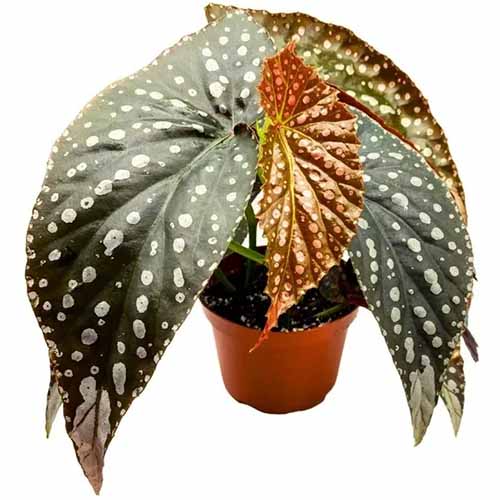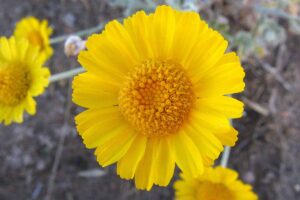Begonia coccinea, B. corallina, B. dietrichiana, and hybrids
I’m proud to say I was not the first in my family to grow and care for an angel-wing begonia houseplant.
That honor goes to my daughter Frances, whose aunt Kathy gave her a five-gallon pot with a large, healthy specimen for her 11th birthday.
She kept it as a houseplant in her sunny bedroom throughout middle school, dragging it outdoors for the summer, carefully watering it, and deadheading the coral pink flowers.
I never had to remind her to care for her angel-wing begonia. She took it on herself to learn about the plant and followed tips from aunt Kathy throughout the three-foot-tall plant’s tenure at our madcap home with the resident blended family of five.
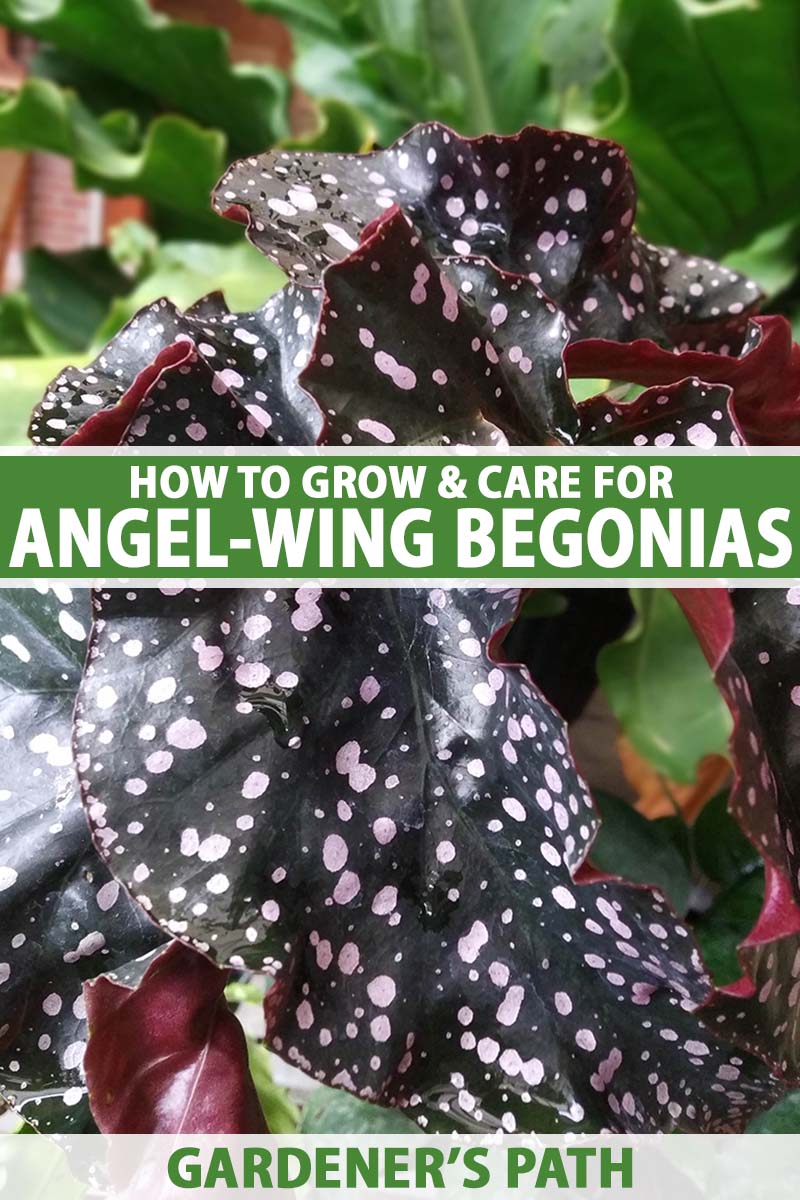
We link to vendors to help you find relevant products. If you buy from one of our links, we may earn a commission.
That plant lived and bloomed for at least six years, a great run for a cane-like variety. I only regret that we didn’t realize how easy it would be to take cuttings and root the stems, or I imagine we’d still have an offspring of that same begonia at Newton Street all these years later.
I circled back to angel-wing begonias a couple of years ago when seeking familiar comforts during lockdown. I purchased them from the same South Knoxville greenhouse Fran’s plant came from.
Hers, mine, and the many other types of angel-wing begonia are outright beauties, especially when you pay attention to their growing requirements. You may wish to cultivate them indoors or outdoors or combine the two approaches.
The common name “angel-wing begonia” is used fairly loosely, creating a bit of a gray area on exactly which plants fall into the category.
I’ll explain more about the classification, including the instances when you want to differentiate among varieties and when it’s cool not to bother with distinctions.
I’ll also share a host of tips on growing and caring for these heavenly begonias.
Here’s what you can expect:
What You’ll Learn
What Are Angel-Wing Begonias?
Angel-wing is the common name for a few different begonias.
Botanical species usually accepted as being in the “angel-wing” category include B. coccinea, B. corallina, and B. dietrichiana.
Common traits include sturdy, upright stems with nodes that make them look a bit like slender bamboo, asymmetrical, wing-shaped leaves, and clusters of pink, white, or red flowers borne on the canes.

The different species grow to between one and six feet tall, though they usually top out at about two to three feet.
Most varieties have light dots or streaks atop their leaves, often with red undersides.
The species B. dietrichiana is known as the “heirloom” angel-wing begonia, and it has smooth green leaves without markings.
Some folks refer to all cane-like begonias as angel-wings, but cane types often have rounded, elongated, or star-shaped leaves.

You may also hear the popular polka dot plant, B. maculata, called “angel-wing,” and it mostly fits with this classification.
Polka dot plants grow thicker canes and waxier leaves than most cane begonias, though, and have larger polka dots than the other species in this grouping.
They don’t flower as consistently as the others, either. They usually bloom only in spring or summer, if then – as opposed to throughout the year. And their blooms are white and tiny, not pink or red.
Just be aware that while polka dot plants and other angel-wing begonias both need well-draining soil and infrequent, deep watering, B. maculata plants are pickier about light and humidity.
Instead of medium light, they’ll need bright, indirect light.
Dragon wing begonias (B. x hybrida) are also sometimes called angel-wings. These plants are a hybrid of B. coccinea and B. semperens, the everblooming wax begonia.
Dragon wings are more compact than other cane-like varieties, with smaller leaves.
I’m not going to talk about the dragon wings in this guide since they are usually considered a separate variety by growers and breeders alike. And as relatively recent hybrids, their growing needs are a bit different.
All the varieties we’ll discuss in this guide have fibrous roots and are easy to start from cuttings.
You can grow these evergreen plants outdoors as perennials only in USDA Hardiness Zones 10 to 11, but they make beautiful houseplants that bloom year-round with proper care.
You can also enjoy them as garden or hanging basket annuals in cooler growing zones and then toss them in the fall. To me it seems like a waste to trash them at the season’s end.
As I mentioned earlier, there are times when it’s important to differentiate between a cane-like angel-wing begonia and other species that look sort of similar.
Hardy begonias, B. grandis, are one example. They have rounded, paisley-shaped leaves that look like wings if you try hard to convince yourself, and they produce flowers similar to many angel-wing types.
The reason you don’t want to accidentally end up with a hardy type when you’re seeking a cane type is that hardy types are not evergreens, so they lose their leaves when the weather gets cold.
Next are the foliage-first rex begonias, B. x rex cultorum. Many of those patterned cultivars have wing shaped-leaves.
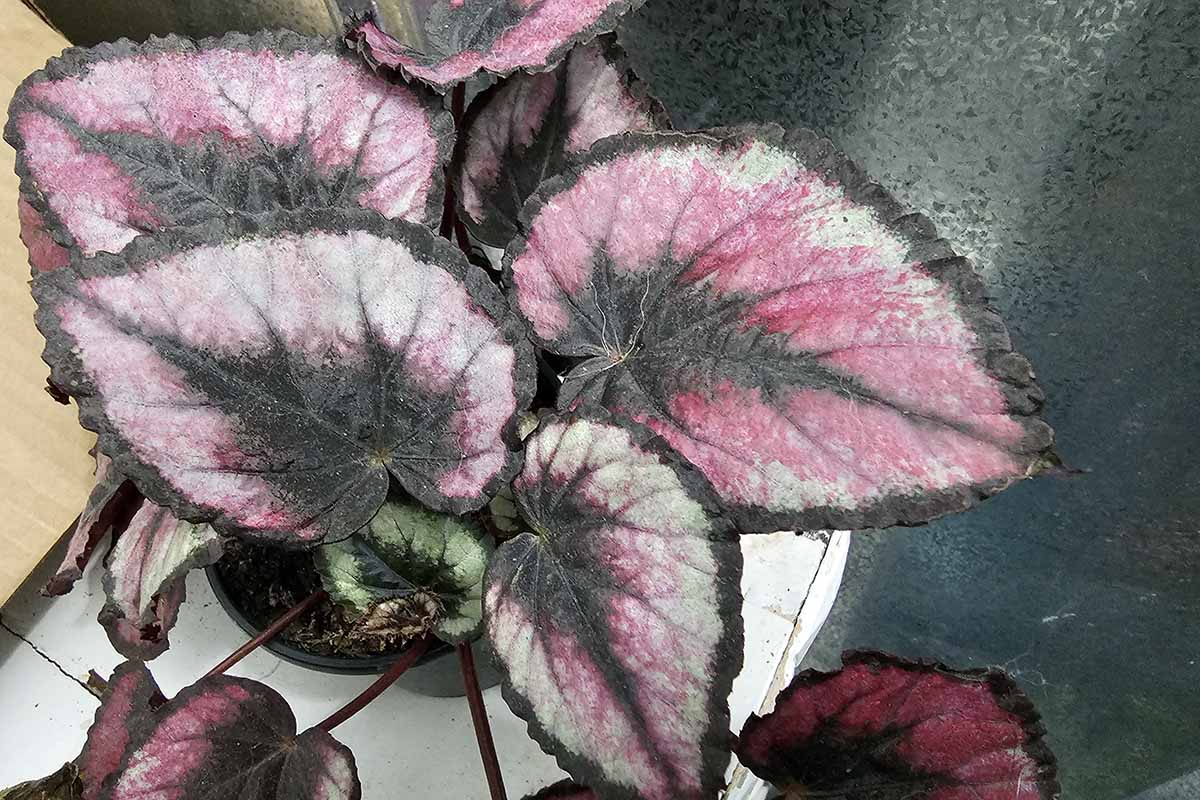
I included a photo of one of my “painted leaf” rex begonias above to show you how easy it would be to think they were angel-wings.
But the rex types are a bit fussier than the cane types, especially when you try to grow them outdoors, and the growing requirements differ somewhat.
Most B. x rex cultorum cultivars sprout leaves from rhizomes, for example, so they need to be positioned with the rhizome half buried in the soil, not planted with the crown at the soil surface like cane varieties.
The lack of canes makes colorful rex begonias more difficult to propagate, too, so they’re not as easy to share as the typical B. corallina or B. coccinea, either.
You’ll find plenty to recommend rex begonia cultivation in our guide.
Ahead of the growing information, let’s take a minute to learn about the background of the graceful, cheerful angel-wing begonia.
Cultivation and History
Angel-wing begonias are part of the cane-like grouping determined by the American Begonia Society. Most of the cane-like species are native to parts of Brazil.
They are all classified within the Begonia genus Franciscan monk and botanist Charles Plumier first described more than four centuries ago, in 1700.
Europeans fell in love with these types of plants quickly, and identified 200 species between 1700 and 1850, and begonias have been popular with flower and indoor gardeners to some degree ever since.
Many begonias, including the cane types, are easily hybridized, and even amateur breeders have successfully introduced new begonia cultivars.
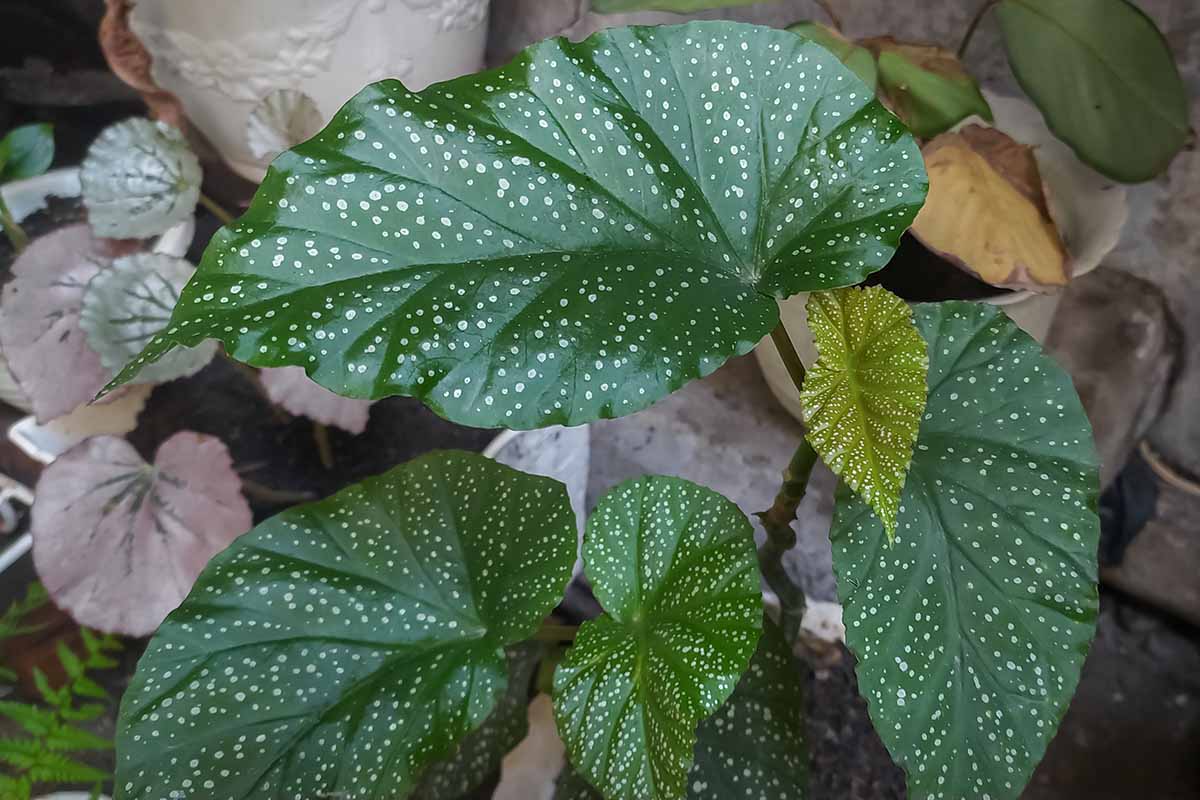
One of the earliest recognizable cultivars was introduced by a Swiss nurseryman in 1892 and is known as B. corallina ‘De Lucerne’ or B. ‘Lucerne.’
It has olive leaves with silver flecks and is a parent plant for many of the varieties popular today.
‘Lucerne’ plants are pretty hard to find at ordinary nurseries in the US but still have their devotees.
According to the American Begonia Society, as more begonias with wing-shaped leaves came on the scene, they too picked up the name angel-wing, even if they were shrubby or trailing, not cane types.
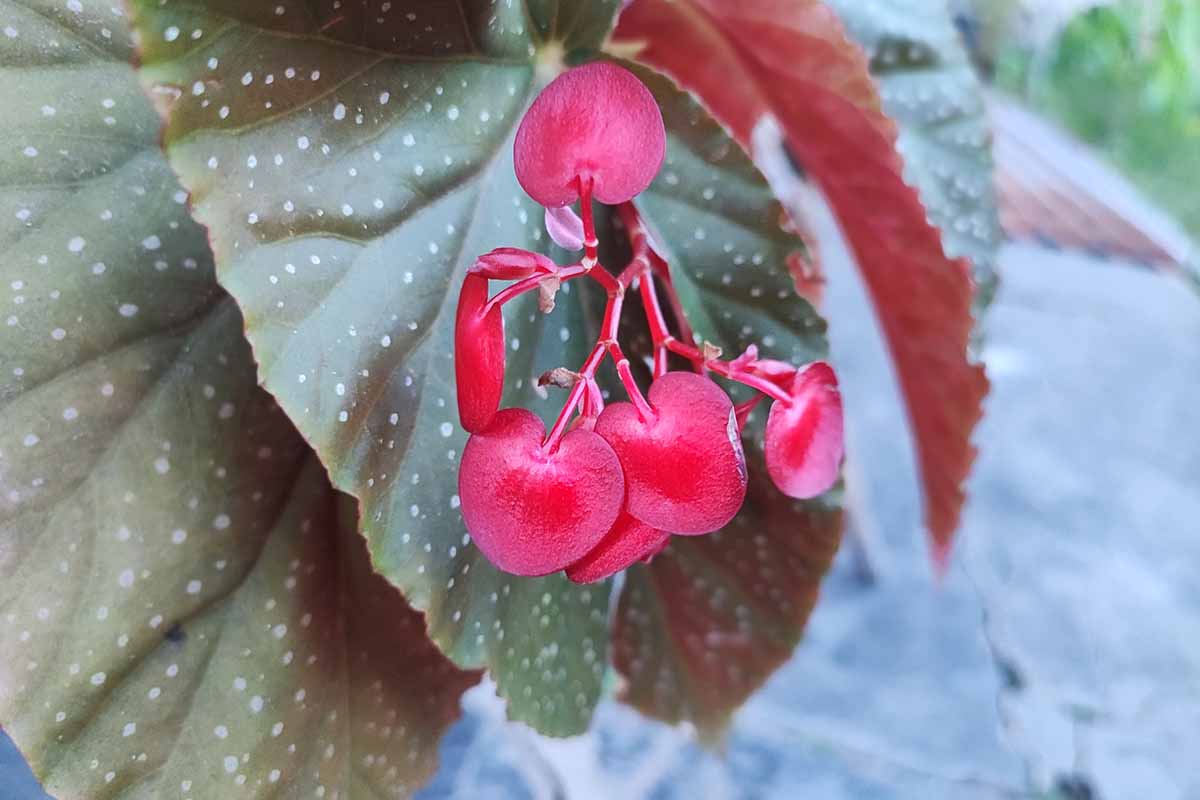
As the years went by and the name started being used indiscriminately, many hybridizers and home growers stopped using it altogether.
Another subgroup of cane types, the Superbas, has many members classified as angel-wings.
A home hybridizer, Eva Kenworthy Gray, pioneered the Superbas. She began crossing fibrous begonia varieties in the 1920s in California.
In 1926, she crossed a Brazilian variety, B. aconitifolia, with a B. coccinea ‘Lucerne’ from a private collection.
The cross resulted in a cane-like variety featuring deep toothed margins and delicate silver markings on large, asymmetrical leaves. The begonia world took note, and other Superba hybrids followed.
They included a cross of ‘Lenore Olivier’ and ‘Kentwood,’ from Gray’s fellow Californian, Irene Nuss.
The resulting cultivar, named ‘Irene Nuss’ has large, deeply frilled bronzed leaves, upright canes, and numerous clusters of oversized pink flowers.
‘Irene Nuss’ won a Royal Horticultural Society’s Award of Garden Merit in 1971 and it has remained popular among Superba fans ever since.
Now that you’ve seen some of the possibilities, let’s talk about how to propagate these plants.
Angel-Wing Begonia Propagation
One of the great joys of owning an angel-wing begonia is being able to root cuttings from it almost at will.
With the ease of that approach, it’s unappealing to try to grow these varieties from seed unless you can find pelleted seeds from a reputable dealer or plant breeder.
Hybrids produce seeds that won’t grow true to the parent plant, and they may be sterile.
Species plants may produce seeds, but they are quite tiny and difficult to work with indoors – you’d need a magnifying glass and at least two people to try.
It’s not feasible to directly sow them in the garden, either – they simply disappear.
With that said, if you luck out on pelleted seeds, sow them indoors eight to 10 weeks ahead of your average last frost date in Zones with cold winters.
You can find step-by-step instructions for starting seeds indoors in our guide, but take into account begonia seeds need light to germinate.
You can also plant pelleted seeds outdoors in Zones 10 to 11.
As for taking cuttings, this is an easy propagation method as they take just a few weeks to root.
You can propagate cane cuttings at any time of year.

Be sure the parent plant is healthy and large enough to lose a few stems and still have at least two-thirds of its foliage remaining, to allow for photosynthesis.
I like to root a couple of canes simultaneously to increase the odds that at least one will succeed, and to have some to share.
Ordinarily I’ll root each stem in its own pot or glass of water so the roots don’t get entangled, but you can propagate several together and then transplant them en masse to grow together if you prefer.
Choose healthy stems that have at least two nodes. Cut a segment about four inches long using sterile scissors or a paring knife.
Pinch off all but the top two sets of leaves.
At this point, you may want to dip the bottom of the clipped stem in rooting hormone to hasten root development. This step isn’t critical, though it will increase your chances of success.
Next, stick the bottom of the stem into a cell, tray, or shallow pot of pre-moistened, well-drained potting mix.
Set the container in a protected spot that receives six hours or more of bright, indirect light without direct sun.
Keep the soil moist with a spray bottle of tepid water, being careful not to get the soil too soggy.
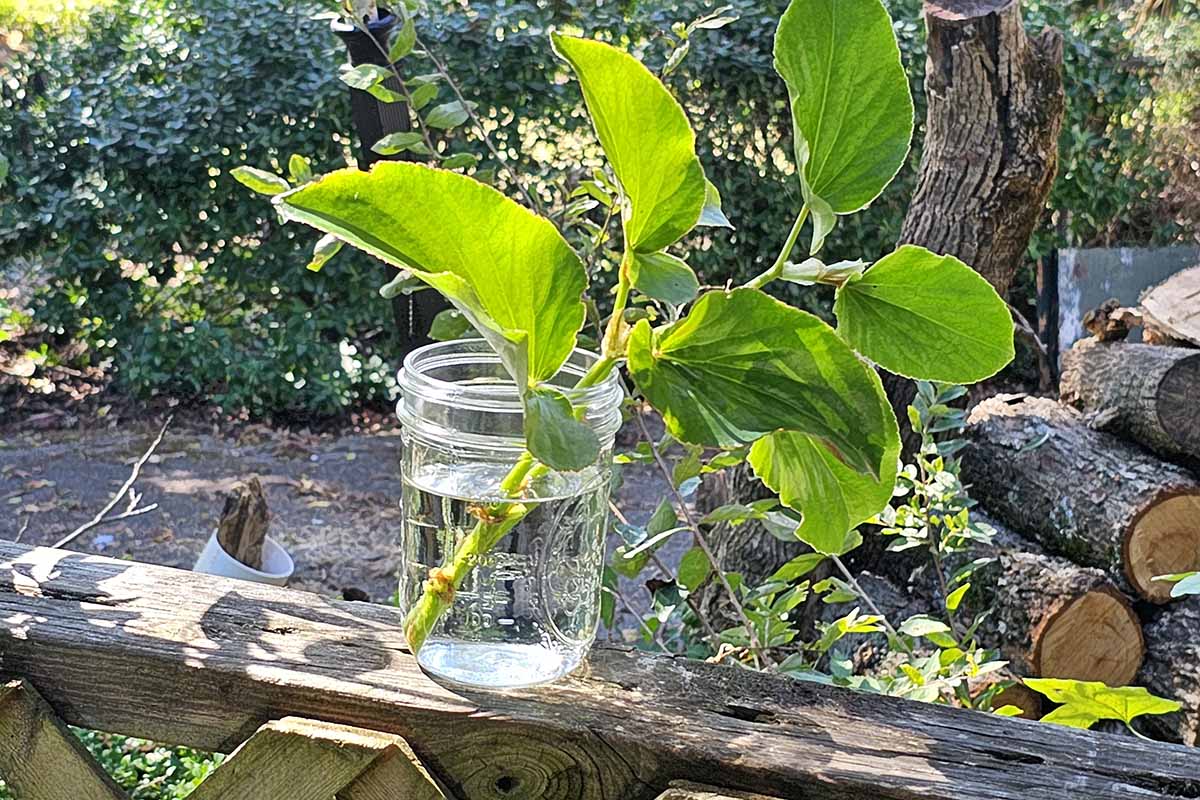
You can also root cuttings in a small glass of water. Make sure the nodes are below the water line, while the leaves stay above it.
Every couple of days, change out the water to prevent rotting.
When the roots are an inch long, you can plant the starts in containers or directly into a raised bed or garden after hardening off the seedlings.
Directions for transplanting are coming right up.
Transplanting
Even the healthiest starts need a bit of TLC at transplant time. Here are the basics:
Outdoors
If you live in Zones 10 to 11 or wish to grow angel-wings as annual bedding plants in Zones 3 to 9, you can transplant store-bought starts or rooted canes directly into a garden or raised bed in spring.
First, it’s advisable to test the soil and amend it as necessary. These plants like a pH of 5.5 to 6.5.
Adding plenty of organic matter will improve drainage, and spacing the plants about 30 inches apart will allow room for air to circulate.
Use a trowel or spade to dig a hole as deep as the current container, and a few inches wider.
Ease each transplant out of its cell or container and set it in the hole so the bottom of the cane is even with the soil surface.
Backfill with well-draining soil.
Water the transplants thoroughly, making sure the soil drains well. Then be extra attentive to keeping the soil consistently moist for the next four to six weeks, until the plants are well-established and can tolerate the occasional dry spell.
Indoors
For my money, containers are the way to go if you live in a cooler climate.
I reason that you’ll need to overwinter the plants indoors, so they’ll need pots and fresh potting mix in late summer regardless.
It’s simpler just to grow them in containers full-time if you live where winters are cold and avoid the stress involved in uprooting bedding plants and getting them acclimated to living in a pot.
Choose a pot with drainage holes that is lightweight for easy toting. If you’re repurposing a container, be sure to wash it first and always use fresh potting mix.
It’s ever so easy to transfer water molds and fungi when you use old soil for a new plant, especially if the former occupant of that pot succumbed to a disease.
The planter should be two or three inches wider than the start or the grower’s pot you’ve purchased.
Fill it with a humus-rich potting mix that’s well-draining and formulated for ornamental indoor plants.
Leave at least an inch between the top of the potting mix and the rim of the planter so the contents won’t spill out when you water.
Find more tips on choosing containers in our guide.
Remove each start from its current pot, tray, or cell by turning the container on its side, then easing the plant out with your fingers, holding the base of the stem and tugging gently.
If you rooted a cutting in water, pull the start up by its stem base, not the leaves.
Create a hole that’s the same depth as the fibrous roots and two inches wider in diameter than the foliage.
Center the start in the hole, backfill with more of the growing medium, and water thoroughly.
From there, get ready to enjoy an indoor flowering plant that’s fast-growing and easy to care for.
How to Grow Angel-Wing Begonias
Angel-wing begonias will reward the effort if you take the time to provide their optimal growing conditions. Here are the basic considerations:
Location
Outdoors, this type of begonia needs well-draining, nutrient rich soil and a part shade exposure.
It can even grow and flower in full shade, but it will have fewer blooms and typically won’t be as full or tall as the ones planted where they receive morning sun and afternoon shade.
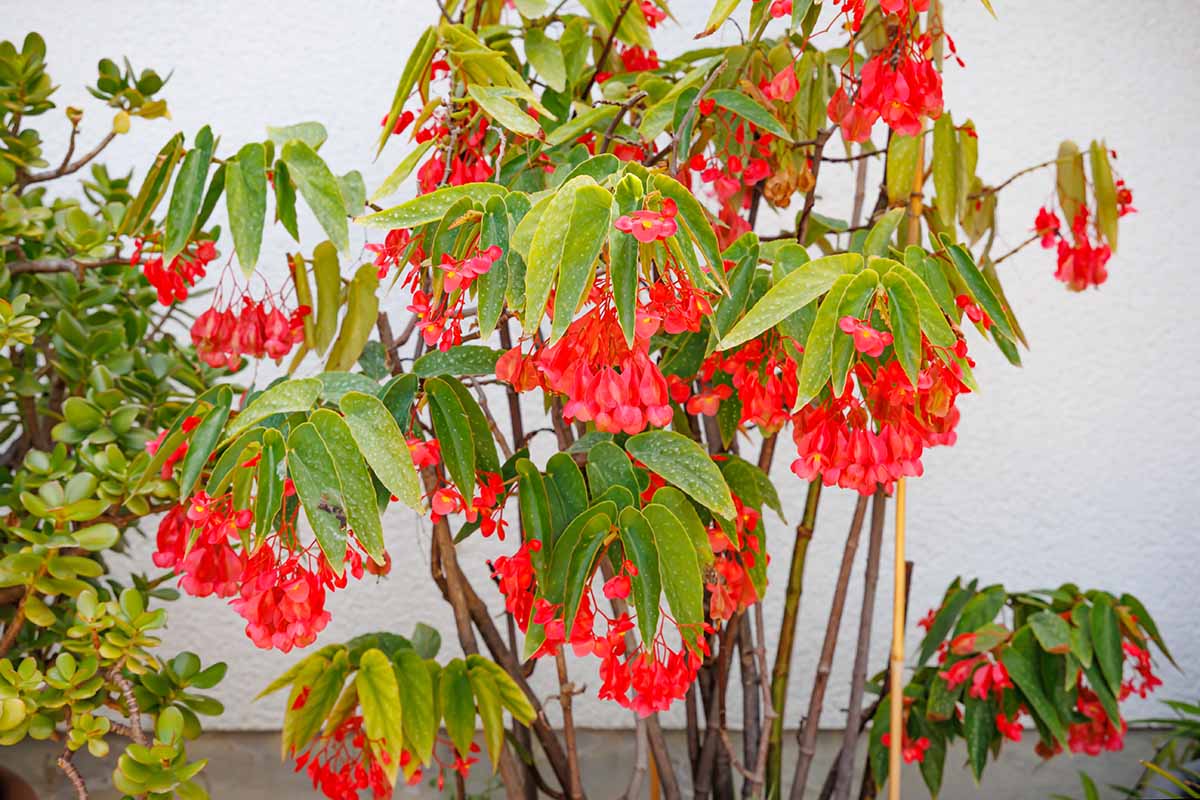
If you live in Zones 10 to 11, you can plant them in the ground. Remember the canes can grow several feet tall, so avoid areas prone to high winds that could knock them over.
In Zones 9 or lower, they can’t grow outdoors full-time and will need a suitable indoor location for at least part of the year.
When considering where to place them, remember all begonias contain insoluble calcium oxalates that can cause reactions including vomiting or salivation when a cat or dog ingests a piece.
Keep the plants on a high shelf, or somewhere else out of reach of inquisitive or foolhardy pets.
I like the top of my fridge as an option, since the kitchen offers ample humidity and the appliance sits in front of a sliding glass door that receives morning light.
Oh, and, even the extra-inquisitive cat won’t climb up there.
Call your veterinarian if your pet samples any part of the plant. The toxic reaction is less of an issue for human kids since biting into a leaf creates an odd taste and unpleasant sensation immediately.
Light
Whether you’re planning to grow angel-wing begonias indoors all year or merely move them inside when it’s cold out, plan to provide a spot with bright to medium-bright light without exposing the leaves to direct sunlight.
It may sound odd that these plants can grow in substantial shade outdoors but need plentiful indirect light indoors, but that’s the way it is.
If you don’t have a space at least a couple of feet from a sunny window available, try using grow lights to provide the necessary illumination.
Temperature
Not too hot, not too cold… the just-right temperature is 70 to 75°F by day and around 60°F at night.
Temperatures between 50 to 60°F may slow growth and blooming, and those over 85°F can stress the plant and cause it to lose leaves or stop flowering.
Of course, it’s tough to control Mother Nature outdoors, but you can use a shade cloth if the heat index is soaring or move container plants inside for a few days.
Inside it’s entirely possible to grow angel-wing begonias in a spot away from drafts and where temperatures don’t fluctuate by more than a few degrees during the day or overnight.
Water
Once plants are established and have acclimated to their growing environment, you’ll need to water them thoroughly, but only when the soil dries out.
These are not the type of plants that respond well to dribs and drabs of water as you pass by, so restrain yourself if you’ve been known to overwater houseplants in the past.
Instead of setting a schedule, water when the top inch or two of the soil is dry. You can determine the moisture level with a moisture meter or by jabbing your pinkie into the edge of the potting mix.
In winter, they usually need less frequent watering, but let the soil be your guide.
Always water the plants until you see water coming out of the bottom drainage holes, using room temperature or tepid water.
I prefer bottom watering, which you can learn more about in our guide.
If you don’t bottom water, make sure to pour water on the soil surface, not over the top of the leaves.
Watering cans are cute, but when you allow water to drip onto the leaf surfaces, they can’t always dry readily, and it might encourage diseases or stem rot.
Let the plants drain into a saucer below for at least 15 minutes after a watering session, and then discard the excess. All begonias loathe wet feet.
Humidity
Begonias thrive in a humidity level of at least 40 percent and as much as 60 percent, but may do okay with slightly less or slightly more.
A good rule of thumb: keep an eye on the foliage. If the leaves start to turn brown at the tips the plants likely need a humidity boost.
Usually, a pebble tray with water beneath the bottom of the pot will work, though if the air is particularly dry in your home, you may want to invest in a humidifier.
Fertilizer
Angel-wing begonias benefit from regular fertilizing when they are actively growing.
About once a month during the spring and summer, apply a liquid 20-20-20 (NPK) fertilizer diluted to half the strength recommended by the manufacturer.
Hold off during fall and winter, and resume again once the plants enter prime growing season in the spring.
For more tips and techniques on growing begonias as houseplants, see our guide.
Growing Tips
- Grow in part shade outdoors and bright to moderate indirect light inside.
- Water thoroughly when the top inch or two of soil is dry.
- From spring to early fall, fertilize once a month with a liquid 20-20-20 fertilizer diluted to half the recommended strength.
- Indoors, maintain daytime temperatures of 70 to 75°F and 60°F at night.
Pruning and Maintenance
Cane begonia varieties can live up to six years before becoming weak and spindly and ready for the compost.
You can promote their health and beauty over the long haul with a few maintenance chores.
First, consistently deadhead the spent blooms, especially on plants grown indoors. Remove any dead leaves or stems that fall on the soil, too, to prevent fungal diseases.

Second, carefully time when you move indoor/outdoor plants to a new locale.
Set text reminders, or use a gardening journal, and watch the weather forecast. These beauties will repay the vigilance!
These ornamentals must come inside ahead of nighttime temperatures falling below 50°F and not go out again until all threat of frost has passed and the weather is reliably 60°F or warmer.
Make the move gradually in the spring so your begonias can get used to the unfamiliar environment. Start by placing the plants outdoors for a few hours on the first day and an extra hour or two on the subsequent three days.
If you move them outdoors suddenly, they may become stressed by the light and temperature fluctuations and drop leaves, stop growing or blooming, or even die back.
As part of your maintenance, it’s a good idea to prune gangly plants on occasion.
Starting when they’re about a year old, trim back the top six inches of the canes in early winter and again in spring. You can also shape the plants or limit their height by trimming off the ends more often.
You’ll eventually need to re-pot them too, but don’t rush. They prefer to be a bit potbound and usually only need a new home once every two or three years.
Move them to a container just two inches wider than their previous home, and consider starting a few cuttings when you do.
Angel-Wing Begonia Cultivars to Select
Because the “angel-wing” moniker is used somewhat indiscriminately, you’ll need to guard against local nursery options that are labeled as angel-wings but are rex or wax begonias, with very different growing needs.
I’ve seen distributors selling coleus, anthurium, and peace lilies under the angel-wing label, too.
Specialty plant nurseries are usually the best source of the rarest varieties, though you may come across them online. In either case, expect to pay a premium for the most unusual ones!
Begonia fan that I am, you know I will advise you to acquire the ones you can get your hands on readily and expand your collection with any “dream” varieties on your list as you find them.
To get you started, check out these cultivars:
Harmony’s Ghost Angel
This hybrid cultivar looks very much alive, with elongated leaves in a sprightly green, draping from upright canes.
With proper light and care, its clusters of white blooms could appear in any season.
The ghostly aspect comes from small donut-shaped blips of luminous white on the leaves, along with random silvery splotches.

Bred to be low-maintenance and resilient, this cane begonia is not a bit scary to care for.
You can find Harmony’s ‘Ghost Angel’ in a six-inch pot available from Bubbleblooms via Amazon.
Harmony’s Little Wing
It’s all about the foliage on this offbeat cultivar that’s an exclusive Harmony hybrid.
Its four-inch leaves are shorter than most similar cane-like varieties and have intriguing indents on the margins.
The colors are eye-catching, from the pink flowers to the moss green leaves with luminous red undersides.
Its light grayish-pink freckles and splotches match the narrow strip of color on the leaf margins.

Call it little, but it’s big on style.
Harmony’s ‘Little Wing’ is available in a six-inch container from BubbleBlooms via Amazon.
Harmony’s Raven
This dramatic variety will lift you up on a raven’s wings.
The leaves start out crinkled and auburn-hued, turning a dark olive green at maturity.
The foliage sports aluminum flecks and spots, with silver tips that would be equally at home on a raven’s wing tips.
Indoors, expect the plant to grow about two feet tall, with the asymmetrical leaves presenting a layered effect.
Harmony’s ‘Raven’ is available in a six-inch pot from Bubbleblooms via Walmart.
My Special Angel
All cane begonias are special in my book, but this one is distinguished by its fairly angular “wings” with wavy margins and silvery spots.
‘My Special Angel’ will grow at least two and a half feet tall at maturity.
In keeping with the angel theme, its silver markings and pink blooms complement plants with red blooms or foliage as part of holiday decor.

‘My Special Angel’ starter plants are available as bare roots from SmartMe via Amazon.
Managing Pests and Disease
These types of begonias are consistently healthy and easy to tend, but can still occasionally have issues with pests and disease. Here’s what to watch for:
Pests
Outdoors, if you’re plagued by deer munching on your trees and plants, you may want to give angel-wing begonias a try – if you’re in a suitable Zone.
The calcium oxalates they produce make the foliage taste bad, but if deer persist, they’ll usually go for smaller specimens they can easily uproot.
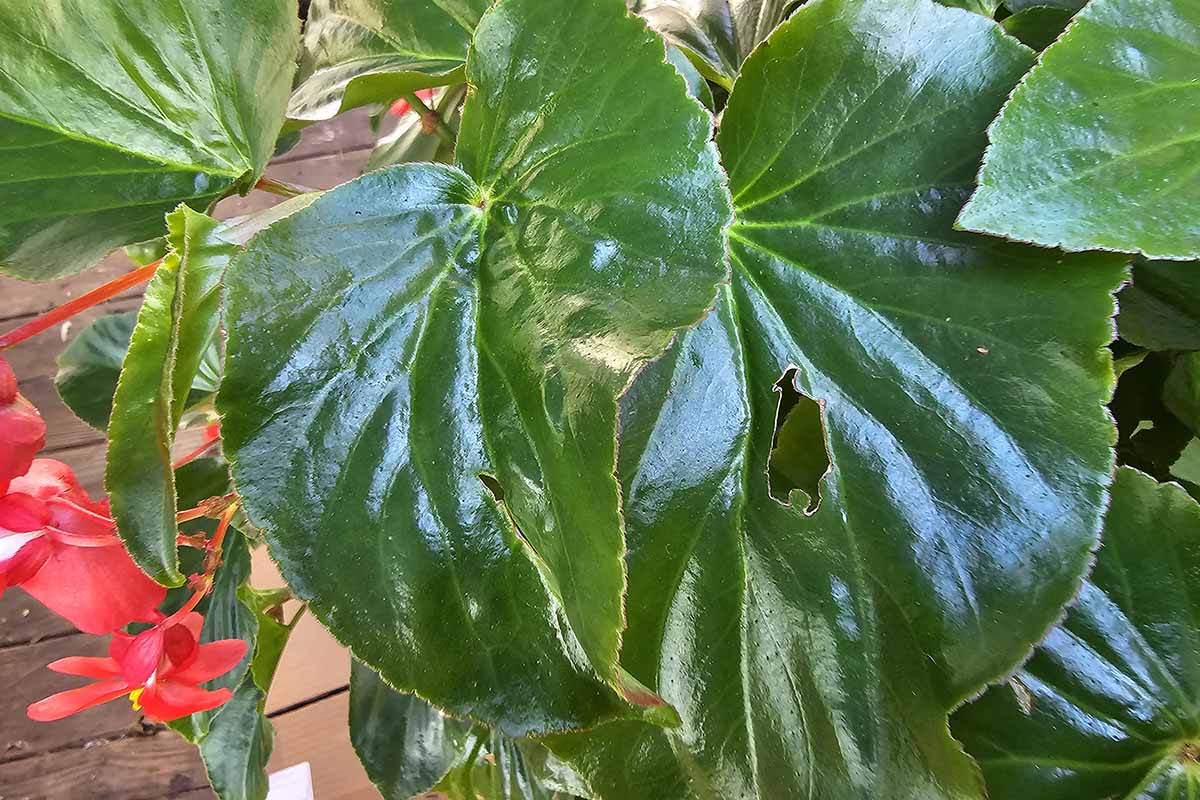
Rabbits, too, are known to avoid the sharp taste of the leaves. But that claim mostly applies to full-grown rabbits since the youngsters don’t have the experience to notice the discouraging taste as quickly.
For them, you may place pots out of reach and use row covers to protect tiny, tender starts early in the spring.
As for insect pests, none of them are particularly fond of angel-wing begonias, but they may infest outdoor plants or jump over to begonias from other infected house or bedding plants.
The best prevention is to check the leaves carefully for insects, spider mites, and gastropods ahead of moving plants inside for the winter.
A blast of water from the hose is usually enough to send these pests on their way. If they keep reinfesting, you may need to turn to an application of neem oil, which acts as a natural fungicide and pesticide.
Some of the most common insects and arachnids you might encounter include spider mites, mealybugs, scale, and thrips. You can find information on detecting and combating each in our guides.
Personally, I’ve had a bit of trouble with snails and slugs while my angel-wing begonias are enjoying the great outdoors in spring.
If you’ve seen jagged holes in the foliage, these gastropods could be the culprit.
Learn to spot snail and slug damage and manage it using tips from our guide.
Disease
You can avoid most ailments that afflict angel-wing begonias by giving them ample space for air circulation, growing them in well-draining soil or potting mix, and never overwatering.
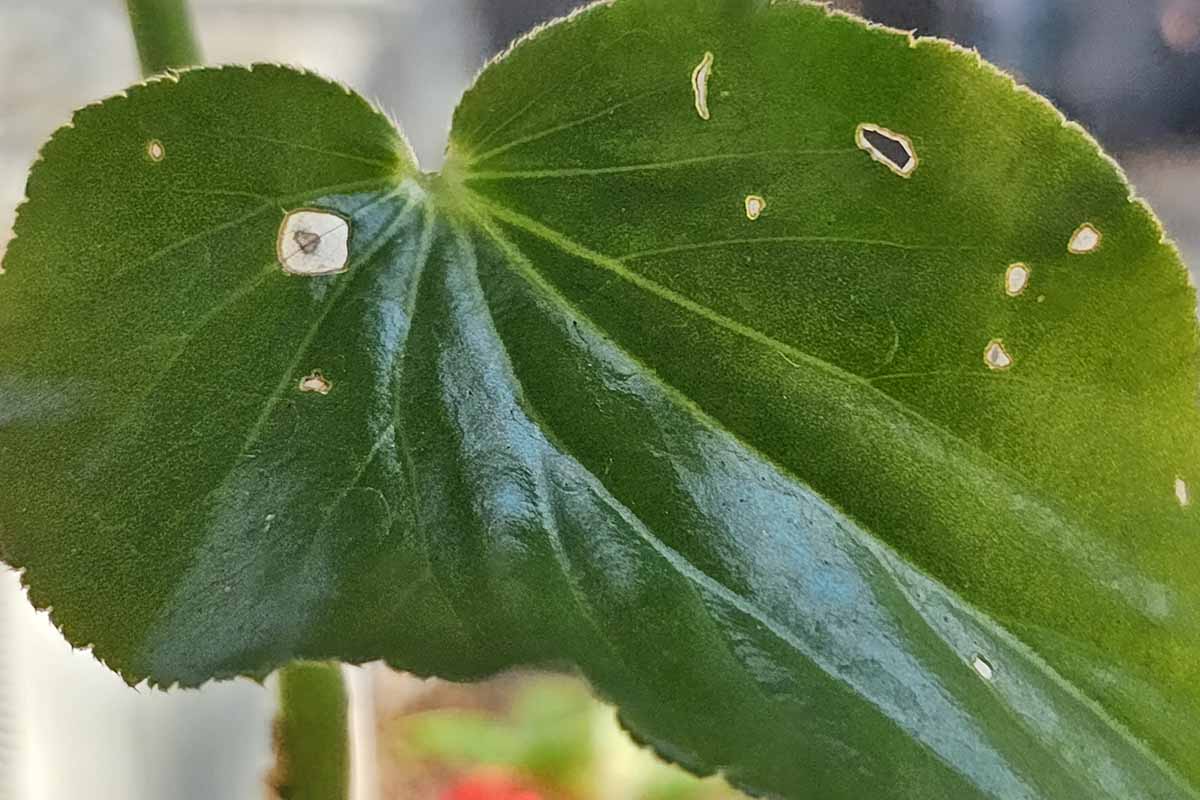
Limiting moisture or standing water below the plants helps reduce the harmful water molds that cause root or stem rot.
Overly damp soil or wet leaves can also result in fungal diseases like powdery mildew and leaf spot.
Be wary of Botrytis cinerea, which causes a disease called botrytis. Its damage appears on the flowers first and can be prevented by consistently deadheading blooms and removing fallen leaf debris.
Best Uses for Angel-Wing Begonias
When you’re an indoor or outdoor gardener who prefers plants that bloom year-round and have evergreen leaves, angel-wing begonias are ideal.
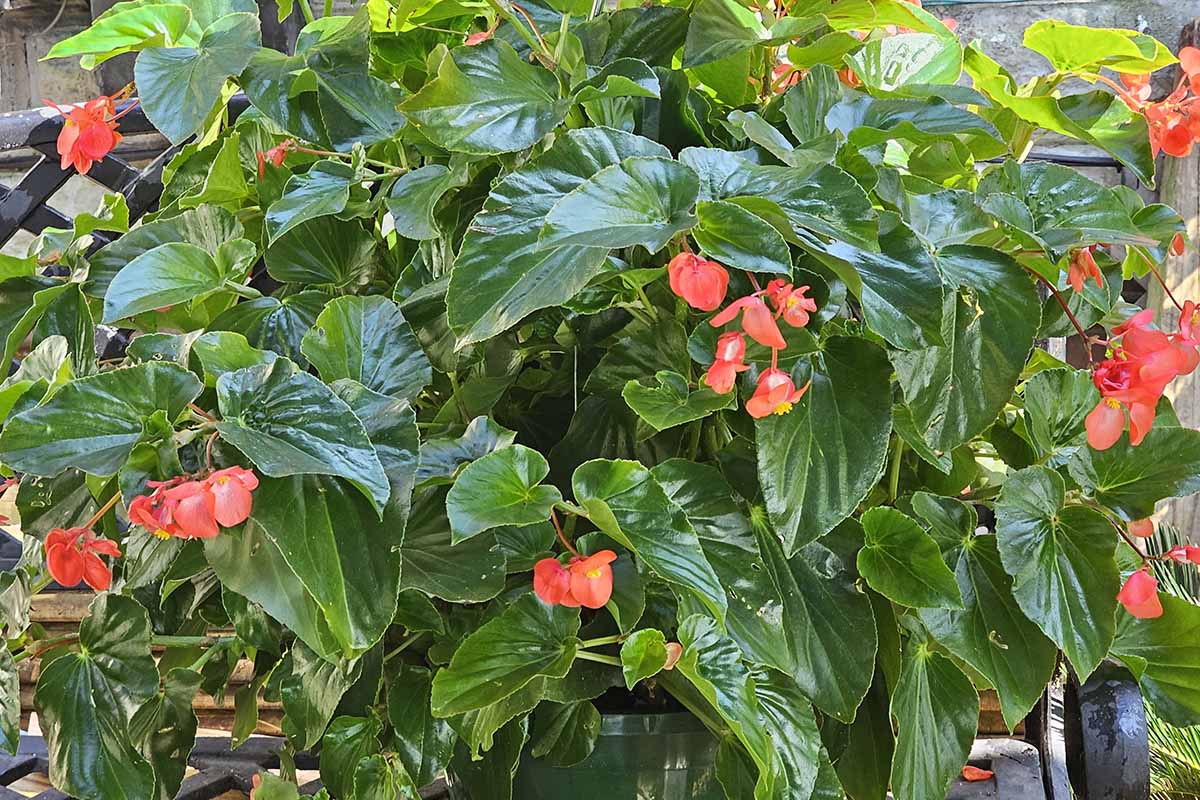
The taller specimens can anchor a spot on a shady patio garden.
Or, you can keep a more modest variety clipped and shaped to serve as a living centerpiece on a well-lit dining room or kitchen table. Just make sure those calcium oxalate-rich leaves don’t fall in the salad!
Window boxes, hanging baskets, a huge pot in the well-lit foyer, or a well-draining garden border lined with wing-shaped foliage and clusters of blooms are only the start. Once you start growing angel-wings and propagating cuttings, you’ll find many uses for them.
Like my sister-in-law, I consider these ornamentals a good gift for an enterprising preteen with a fondness for flowers and a green thumb. Or, give one to yourself!
Quick Reference Growing Guide
| Plant Type: | Flowering herbaceous perennial | Flower/Foliage Color: | Coral, pink, red, or white/Bright green, burgundy, green-gray, or silver with light dots in buff, silver, pink, white |
| Native to: | Brazil | Water Needs: | Moderate |
| Hardiness (USDA Zones): | 10-11 | Maintenance: | Low |
| Bloom Time/Season: | Year-round | Tolerance: | Adult rabbits, deer, some drought, heat |
| Exposure: | Bright, indirect light (indoors), full to part shade (outdoors), no direct sun | Soil Type: | Porous, peat-based growing mix formulated for indoor plants; well-draining humusy soil (bedding plants) |
| Spacing: | Pot 2-3 inches wider than root ball, bedding plants 2-3 feet apart | Soil pH: | 6.0-7.0 |
| Planting Depth: | Soil surface (seeds), even with soil surface (transplants) | Soil Drainage: | Well-draining |
| Height: | 2-5 feet | Family: | Begoniaceae |
| Spread: | 2-3 feet | Genus: | Begonia |
| Common Pests and Diseases: | Mealybugs, scale, slugs and snails, spider mites, thrips; Botrytis, leaf spot, powdery mildew, root and stem rot | Species: | Coccinea, corillina, dietrichiana, B. x hybrida |
A Host of Angelic Begonias
If you’ve ever conversed with me about hobbies for more than 15 minutes, you’ve already learned I’m enamored with begonias.

Colorful rex begonia varieties with artful, patterned leaves are always a top choice.
But angel-wing varieties have also earned my adoration with their shapely leaves and bright blooms.
Part of the draw is the family tie I told you about. But the ease of propagating from canes is what truly sets these varieties above other begonias, for me at least.
A few weeks in a cup of water, and presto! You have more cheery plants to share with your friends.
How about you? If you’ve grown these before, indoors or out, we’d love to receive your anecdotal advice or questions in the comments section below.
And for more information about growing begonias, check out these guides next:
